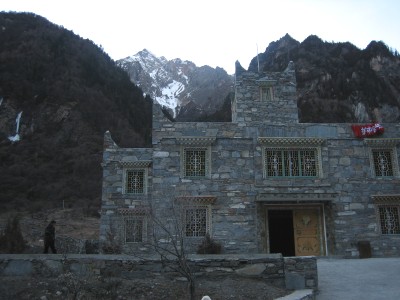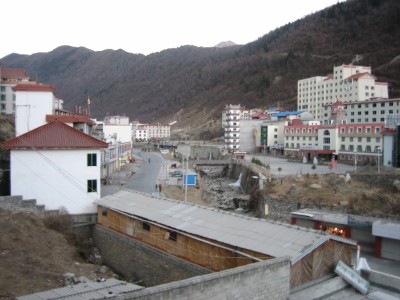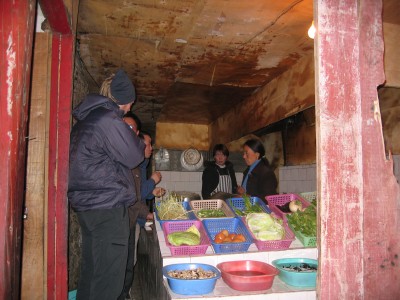Ice climbing in Shuangqiao Valley, Sichuan, ChinaDecember 28, 2005- January 15, 2006
Recognizance of the valley and rest day in Rilong city |
|
Although the two first days of climbing had been quite easy we decided to have a rest day on New Years day so we could drive with the owner of the guest house drove to the end of the 36 km long valley. We wanted to see what kind of climbs that were available so we could prioritize the remaining 2 weeks in the valley. The inner part of the valley seen from above. Abi mountain is seen above Martin in the horizon. |
The first stop was at a checkpoint at the fire station a few kilometers into the valley from the guest house. As noted previously there was hardly any snow anywhere, which was somewhat unusual. Due to the dry season they were worried about forest fires, which apparently was the reason for the checkpoint. However, they never questioned us or warned us about the risk of fires, so it seemed a bit silly. Luckily, they always let us in without any major trouble - not least thanks to Jeffry and the owner of the guest house who did all the talking.
The fire station in the middle of the valley. We needed permission to pass it due to the dry winter -> they were afraid of forest fire. Carsten and I climbed in the side valley behind the fire station on the last day (Route 8) |
It was great to see the valley and the mountains surrounding it. In particular Abi mountain and Five Color mountain stood out as particularly beautiful - it would be great to return one day to climb them!
The beautiful Five Color mountain range with amazing color bands on the faces. |
Once again we were reminded of the Tibetan cultural influence in the area when we passed a shrine with prayer flags. As costums calls for we took a rock, walked three times around the shrine and then placed it on the shrine. That should protect us from accidents - and it worked as all four of us came home in one piece!
The team in front of a Tibetan shrine in the valley. Abi mountain is seen above our heads. |
On both sides of the valley we saw a lot of ice lines. In general the routes were very long (> 500 m), but most of them only contained a couple of rope lengths of steep WI4-6 ice, intersected with long sections of WI2-3 ice. The routes on the east side of the road looked sun bleached and thus not very attractive, whereas most of the routes on the west side of the road were in the shade most of the day and looked to be in perfect condition. It was really great to just stand on the road and marvel at all the possibilities. It was equally great not to have any prior information on the difficulties of the climbs - this would be true onsight climbing where we would climb a line until it became too difficult or until darkness. What an adventure! Beautiful Abi mountain in the end of the valley, which saw its first ascent as late as 2004 (via the clearly visible couloir and then op the right-hand face). Another mountain in the valley that just screamed "CLIMB ME"!
|
After our recognizance trip, we drove to Rilong which is the closest city just outside of the entrance to the valley. The guest house we stayed in had electricity but no heat or running water, and we thus wanted to get a warm bath.
Rilong city. The closest place to shop and get a hot bath. |
There was several hotels in the city, but everything was closed for the low season (in the summer a lot of people come to the valley, but hardly anyone come in the winter except for a few crazy ice climbers....). However, Jeffry had organized to open a couple of hotel rooms and turn on the water heaters, so we got a warm shower in a non-heated room at 0 °C, but it was still quite nice. Nevertheless, it was not really worth the trouble to go to Rilong to shower, so we only did it once.
Carsten "enjoying" a shave in an ice cold hotel room. |
Afterwards, we went for a bit of tourist shopping and a dinner composed of self-selected ingredients - yum yum.
Martin and Jeffry deciding what's for dinner. Amazing how delicious dinners they were able to cook from pretty basic ingredients. |
And finally, we went to a local climbers hang-out which had some interesting old climbing equipment hanging on the wall. Charles and the other Chinese climbers we met mainly used western equipment, which was a bit surprising to me. But at least some Chinese are now earning a decent salary, and it is clear to me that they have a rapidly growing middle- and upper class, who can afford to climb.
A friend of Jeffry's making espresso to us in the climbers hang-out in Rilong. Better than in Italy! |
|






